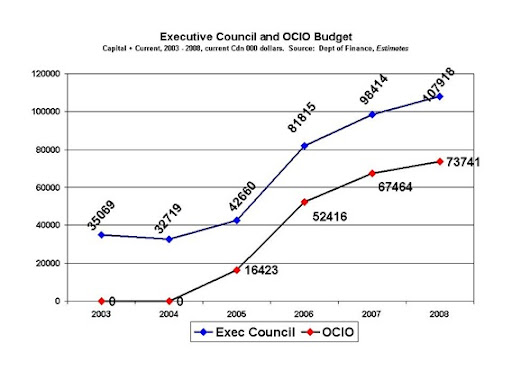One of the things that keeps your humble e-scribbler entertained during the drizzly, foggy nights of capelin weather is comparing news reports.
On Tuesday, there was Premier Danny Williams' opening remarks to the annual NOIA oil and gas conference in St. John's.
CBC was hyping the thing despite there being no concrete evidence whatsoever that Williams was even vaguely contemplating announcing the conclusion of Hebron deal. The reasons behind the hype-fest are as inscrutable as the real reasons for the whole Andy to the CNLOPB or Andy to the PUB thing.
CBC even gifted the Premier with 15 minutes of free province-wide airtime right before the 9:00 work whistle started so that he could deliver a yawner of a stock speech. He didn't ask for it; they gave it willingly and based on absolutely squat in the way of concrete information.
There were no hotel spaces booked for the launch. No sign of print work or any of the other things that would happen if there was going to be a major announcement of a final and binding agreement between the provincial energy company and the oil companies on Hebron.
And if the absence of all those usual indicators wasn't enough, and just to make it overwhelmingly clear, bear in mind that no less a personage than the Premier himself poured cold water over the whole idea of a Hebron announcement coming in his in his Tuesday remarks.
"I can't be overly optimistic that we will achieve it by next week," said Williams on Friday, but said a 25-per cent chance is a fair statement that an announcement will come next week. "I can tell you, though, that I'm extremely confident that this is going to get done in reasonable time frame.".
Williams said the confidentiality part of the agreement is the biggest hold up, especially now that the province owns an equity stake in Hebron.
That was the
Telly version. Other media carried similar remarks either from the Premier or from his spokesperson who used, one must note the exact same words about the percentage chance of an announcement.
So then came the speech and the Premier's predictions were dead on.
With the Hebron speculation proven hollow, both
CBC and the
Telegram used the possibility of a new development application for Hibernia South to lede their stories on the speech. The timeline of that issue given by the Premier could be another post, but let's stick with Hebron.
In the
scrum, the Premier was asked about the negotiations. He gave a slightly different version of the negotiations than we've heard before, saying that at one point he'd anticipated a deal by the first of April.
Well, when the memorandum of understanding was released, the final legal agreements were expected within a "
few months." When the end of the year came, the deal date was moved to February.
April wasn't discussed publicly but at one point in the spring, the Premier said the whole thing was slow because the oil companies' approval processes weren't as swift as those of the provincial government.
The expected date for a deal was June. Now it's the first week of August. Anyone notice the "two months hence" pattern?
Anyway...
Note the comment in the scrum about about the current talks and what's being discussed on Hebron.
Confidentiality was dealt with "some time ago."
No news stories have mentioned that discrepancy and it isn't a small one. In fact, it leads you to the issues mentioned by the oil companies in a
Financial Post story last week. They talked about questions about how much of the work would be done in Newfoundland and Labrador, how the province would pay for its share of the costs and how the oil companies will shift around their shares to give a few to the province's energy company.
No one in the local patch has questioned whether a Hebron deal would be finalized. They've known the deal would have to get done since the MOU was announced last August.
How much work gets done in this province - forget the GBS because that was a given before talks broke off in 2006 - is an issue that the local oil industry is extremely concerned about.
If you skip past the superficial comments and the hype and recognize the obvious disinformation about the confidentiality portion of the deal, you might start to wonder if the oil companies are concerned about whether the local labour market can handle the Hebron project what with most of the province's skilled tradesmen off in Alberta.
They wouldn't want to be tied to performance commitments the local labour market can't keep unless the provincial government was prepared to either relax the local benefits provisions or step in a share the increased costs of doing work locally and shipping in the workers to do it from Heaven knows where. After all, the oil companies want the job done quickly, cheaply and on time. If they have to meet political targets - versus business ones - they'd like to offload those on someone else and who better, in their minds, than the energy company owned by the people who are pushing for the political targets?
If that's what the hang-up in Hebron talks is really all about, that would be a significant conundrum for the provincial government and it would certainly cover off two of the three items the industry representatives mentioned to the
Financial Post.
A deal will get done, but if that's the sort of thing that is currently holding things up, it's a major point of disagreement. We may not see a deal for a few months beyond August.
Overall, though, it's interesting to examine the news because sometimes what's reported as news isn't real news at all. There's was no likelihood of a Hebron deal this week and the Premier said so.
Sometimes, the real story is missed entirely even when it's right in front of everyone's face. It didn't make it into the first news cycle. As with the negotiations, let's see what tomorrow brings.
-srbp-






